Best Natural Christmas Trees 2025
- October 16, 2023
- 0 comment
When the holiday season rolls around, one of the most cherished traditions in my household is picking out the perfect natural Christmas tree. There’s nothing quite like the aroma of fresh pine filling the air and the joy of decorating it with sparkling ornaments and twinkling lights. Over the years, I’ve had the pleasure of exploring various types of natural Christmas trees, and I’d like to share my experiences and recommendations with you.
Best Natural Christmas Trees 2025 List:
- Balsam Fir Tree: Classic and Timeless
- Colorado Blue Spruce Tree: Prettiest Christmas Tree
- Scotch Pine Tree: A Rustic Classic
- Canaan Fir Tree: Newest to the Market
- White Spruce Tree: Best Christmas Tree for Ornaments
- Arizona Cypress: Best Slim Christmas Tree
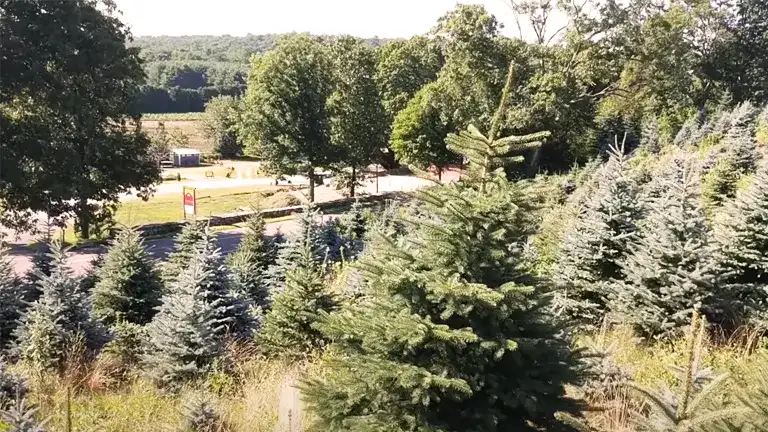
Amidst the array of heartwarming Christmas traditions, few experiences can match the sheer enchantment of strolling through a Christmas tree farm. It’s those brisk afternoons when you find yourself wandering between fragrant rows of pine, fir, and spruce trees. And then, in a moment of pure serendipity, it appears before you—the one tree that seems destined to grace your living room, swathed in your favorite Christmas ribbons, bedecked with cherished ornaments, and crowned with an exquisite tree topper. For some, the act of selecting the tree itself rivals the joy of decorating it!
If you share Ree Drummond’s passion for the authenticity of a real tree each year, you’ll find yourself exploring the diverse species of Christmas trees, searching for the perfect fit for your home. Ree’s choice is an impressive 12-foot Noble fir, radiating full-bodied splendor. “The captivating fragrance that wafts through your home is an integral part of the Christmas tree’s charm,” she attests. If aroma ranks high on your list of priorities, you might also consider the aromatic Balsam Fir or the fragrant White Fir, which we’ve detailed below.
No matter your preferences, there exists an ideal tree waiting to be discovered. Whether you seek low-maintenance options, space-savvy choices, or pure aesthetic appeal, the options are aplenty. For traditionalists, the classic White Pine or the ever-popular Douglas Fir may tick all the boxes. If you’re in the mood for something a touch more unconventional, the Leyland Cypress might pique your interest. Those who cherish their handmade DIY Christmas ornaments each year might want to explore the White Spruce, featuring short, sturdy needles that can bear the weight of even the most elaborate decorations and garlands. And for those who might be considering an artificial tree, we’ve even included one so lifelike that it could perhaps pass muster with The Pioneer Woman herself.
Selecting the Best Natural Christmas Trees
Selecting the perfect natural Christmas tree is a cherished tradition that sets the tone for a joyous holiday season. The first step in finding your ideal tree is to consider the size and shape that will best fit your living space. Measure the height and width of the area where you plan to place the tree to ensure it won’t overpower the room or obstruct pathways. Keep in mind that taller trees tend to have a more majestic appearance, while shorter trees are better suited for cozier spaces. The shape of the tree is another essential factor.
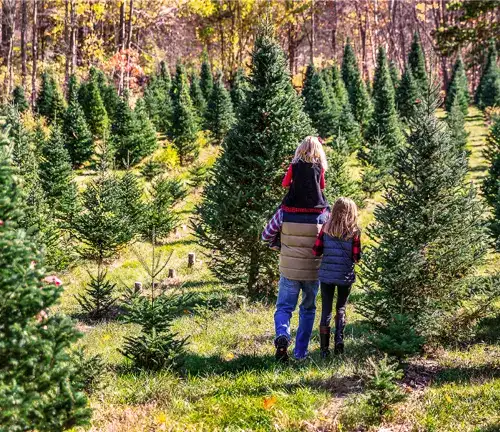
Trees like the Noble Fir and Fraser Fir are known for their symmetrical, full-bodied shapes, making them ideal for displaying a wide range of ornaments. On the other hand, the White Pine’s slender branches offer an elegant, minimalistic look. The choice of tree species plays a significant role in your Christmas tree’s overall aesthetic and aroma. Different varieties offer distinct characteristics, so it’s essential to pick one that aligns with your preferences.
The Balsam Fir and White Fir are renowned for their delightful, woodsy fragrances, filling your home with the classic Christmas scent. If you favor long-lasting freshness, the Fraser Fir is an excellent option, boasting soft needles and a robust structure. Meanwhile, the Scotch Pine exudes a rustic charm with its bright green needles, though it may require regular watering to maintain its needle retention. Finally, the Noble Fir combines regal aesthetics with exceptional needle retention, ensuring a stunning and long-lasting holiday centerpiece. By taking these factors into account, you can select the best natural Christmas tree that suits your home and enhances the magic of the holiday season.
Balsam Fir: Classic and Timeless
The Balsam Fir tree, known scientifically as Abies balsamea, stands as a true testament to the enchanting beauty of the natural world. Hailing from the pristine boreal forests of northeastern North America, this remarkable evergreen conifer exudes an aura of elegance and timelessness. With its gracefully conical shape and lush, aromatic foliage, the Balsam Fir has earned its place as an icon of both the forested wilderness and the holiday season, where it often takes center stage as a beloved Christmas tree.
What truly sets the Balsam Fir apart is not merely its appearance but also the sensory journey it offers, courtesy of its delicate, fragrant needles and the unforgettable memories it weaves beneath its welcoming branches. In this exploration, we will delve into the captivating world of the Balsam Fir, a tree that has the power to transport us to a realm of natural wonder and serenity.
The Forest’s Guardian
The Balsam Fir, with its regal stature and towering presence, is indeed a symbol of nature’s grandeur. Upon my first encounter with this remarkable conifer, I couldn’t help but be awestruck by its majestic bearing. It stands tall and proud as if it were the forest’s guardian, its evergreen branches reaching skyward. Scientifically known as Abies balsamea, this magnificent tree is a native of the northeastern regions of North America, where it thrives in the cool, moist environments of the boreal forest. The Balsam Fir’s conical shape and dense, emerald-green foliage render it a living embodiment of what we envision when picturing the quintessential Christmas tree. Its role in the forest ecosystem is equally significant, as it provides shelter, sustenance, and beauty to the creatures and flora that inhabit its pristine habitat.
Aromatic Elegance
One of the most alluring characteristics of the Balsam Fir lies in its distinctive and enchanting aroma. My first steps towards the tree were met with a fragrance that was nothing short of delightful. The needles, fine and flat, emit a scent that is both invigorating and soothing. This fresh, crisp aroma evokes cherished memories of winter holidays, cozy evenings by the fireplace, and the enchanting spirit of the season.
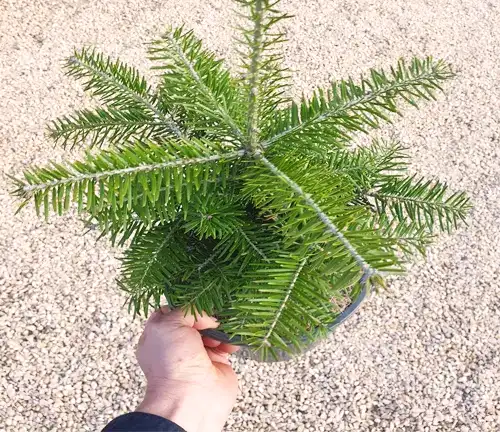
It is this unmistakable scent that has endeared the Balsam Fir to many, turning it into a cherished presence not only in the heart of the forest but also, more intimately, in our homes during the holiday season. This aromatic elegance, an olfactory gift from the Balsam Fir, serves as a reminder of the tree’s remarkable connection to the human experience and its profound influence on our sensory perceptions of the natural world.
Proper Pruning for the Balsam Fir Tree
Pruning a Balsam Fir tree is a delicate process that, when done correctly, can help maintain its health, shape, and aesthetic appeal. However, it’s crucial to approach pruning with care and respect for the tree’s natural form. Here are some guidelines for proper pruning of the Balsam Fir:
- Timing and Frequency: Balsam Firs should be pruned sparingly and during specific times to minimize stress on the tree. The best time for pruning is late winter or early spring when the tree is still dormant. This allows for the tree to heal and recover before the active growth period begins in spring. Avoid pruning in the fall, as this can make the tree more vulnerable to winter stress. Additionally, it’s generally advisable to limit pruning to only what is necessary, focusing on dead, diseased, or damaged branches. Over-pruning can weaken the tree and lead to an unnatural appearance.
- Pruning Techniques: When pruning the Balsam Fir, always use sharp, clean pruning shears or saws to make precise cuts. Begin by removing any dead, diseased, or broken branches, making clean cuts just outside the branch collar (the swollen area at the base of the branch where it connects to the main stem). Avoid leaving stubs or making flush cuts, as this can inhibit proper healing and potentially invite disease or pests. If you need to shape the tree or reduce its size, do so with restraint, maintaining the tree’s natural form. Remember that the Balsam Fir’s needles and branches are its primary means of photosynthesis and energy storage, so over-pruning can have adverse effects on its overall health.
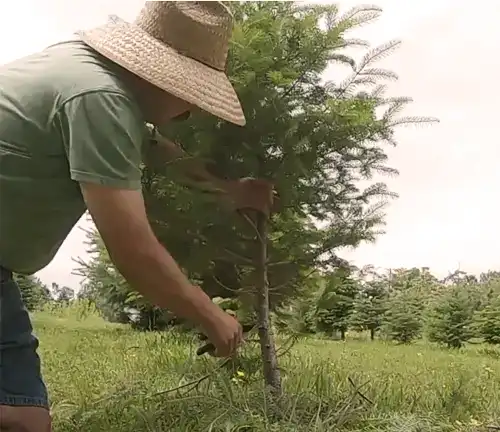
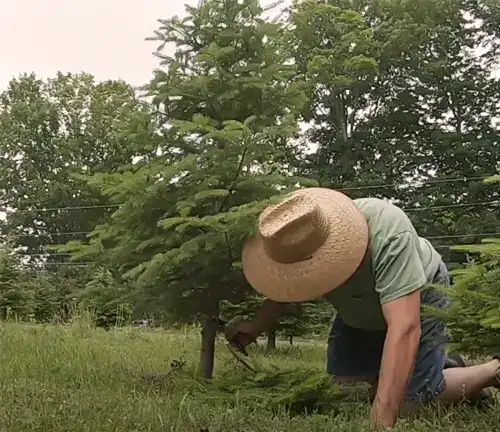
Pros and Cons
Pros
- Aesthetic Beauty: The Balsam Fir is renowned for its graceful, conical shape and vibrant green foliage, making it a visually stunning addition to landscapes and a popular choice as a Christmas tree. Its aromatic needles and distinctive appearance enhance the festive atmosphere during the holiday season.
- Aromatic Delight: One of the tree’s most cherished attributes is its delightful fragrance. The Balsam Fir emits a fresh, crisp scent that evokes a sense of tranquility and nostalgia, making it a desirable choice for wreaths, garlands, and other holiday decorations.
- Wildlife Habitat: The Balsam Fir provides shelter and food for various wildlife species, such as squirrels and crossbills, enhancing biodiversity in forest ecosystems. Its cones serve as a valuable food source during the winter months, helping sustain local fauna.
- Resilience and Adaptability: Balsam Firs are hardy trees that can adapt to a range of soil conditions and climates, thriving in the cool, moist environments of the boreal forest. They can also withstand moderate drought, making them a resilient choice for reforestation and afforestation efforts.
Cons
- Susceptibility to Pests and Disease: Balsam Firs are vulnerable to various pests and diseases, including balsam woolly adelgid and spruce budworm. These threats can weaken or even kill the tree, requiring vigilant monitoring and management in affected regions.
- Needle Drop: While the Balsam Fir’s needles are prized for their fragrance and appearance, they tend to drop fairly quickly once cut, especially if not adequately watered. This can result in a mess and a need for regular maintenance when used as a Christmas tree.
- Limited Lifespan as a Landscape Tree: When used as an ornamental landscape tree, Balsam Firs have a relatively short lifespan compared to other tree species. They are typically best suited for temporary landscaping, such as during the holiday season.
- Competitive Growth: In densely populated forests, Balsam Firs can outcompete other tree species, leading to a decrease in biodiversity. This may disrupt the balance of the forest ecosystem, affecting both flora and fauna diversity. Proper forest management is essential to mitigate these effects.
Nature’s Perfection of Balsam Fir Needles
The Balsam Fir’s needles are a living testament to the splendor of nature’s design. As I gently ran my fingers through the soft, flat needles, I couldn’t help but be entranced by their delicate beauty. Measuring around one inch in length, these needles are meticulously arranged in pairs along the tree’s branches, creating a symmetrical and aesthetically pleasing pattern. Their vibrant green color and smooth texture are clear indicators of the tree’s robust health and vitality, as only a thriving Balsam Fir can boast such a resplendent display of needles. What truly sets these needles apart is their unique design, which allows the Balsam Fir to be easily distinguished from other evergreen species. They lend the tree an exquisite charm that captures the essence of pristine, unspoiled nature and serves as a testament to the remarkable intricacies of the natural world.
Colorado Blue Spruce Tree: Prettiest Christmas Tree
The Colorado Blue Spruce, known scientifically as Picea pungens, is a stunning and iconic evergreen tree native to the Rocky Mountains of North America. Revered for its striking silvery-blue needles, this majestic conifer has earned a well-deserved reputation as one of the most beloved and enduring additions to gardens and landscapes across the United States. Its distinctive appearance, coupled with its impressive adaptability, has made it a symbol of timeless beauty and a testament to nature’s artistry.
Standing tall and proud, the Colorado Blue Spruce’s branches reach out like nature’s arms to provide an exquisite contrast against the backdrop of its deep green surroundings. The name “blue spruce” aptly describes the remarkable hue of its needles, which range from silver-blue to a vibrant, almost turquoise blue, depending on the variety. This distinct coloration is due to a waxy coating on the needles, offering a delightful play of light and shadow that captures the essence of this evergreen’s unique allure. In this review, we will delve into the life and essence of the Colorado Blue Spruce, exploring its history, characteristics, and enduring appeal that has made it a cherished addition to gardens and landscapes for generations.
Winter Wonderland All Year Round
The Colorado Blue Spruce is a true marvel that graces the garden with its beauty throughout every season. In the spring and summer, it offers a cool and refreshing oasis, providing welcome shade for those seeking a respite from the sun’s sweltering embrace. Its dense, silvery-blue needles and gracefully drooping branches create a tranquil ambiance, making it an ideal spot for leisurely outdoor moments. Moreover, it generously serves as a shelter for local birds, who find solace in its branches, adding life and melody to the garden.
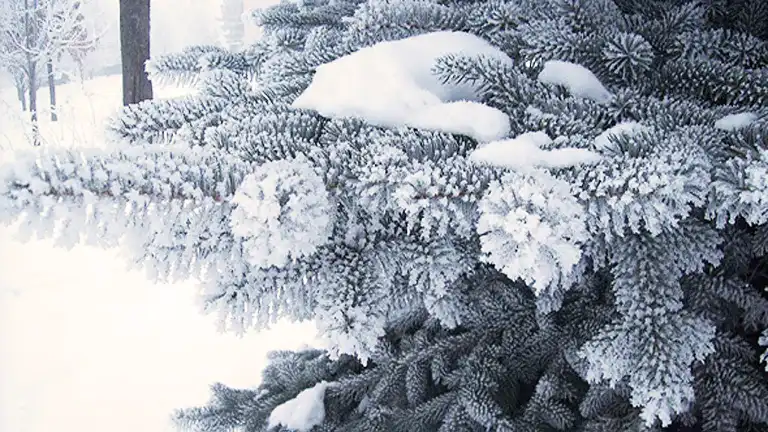
However, it’s during the winter months that the Colorado Blue Spruce takes its place as a captivating centerpiece. As the first snowflakes descend, this majestic evergreen comes alive, transforming into a mesmerizing winter wonderland. With branches that stand firm and sturdy, it bears the weight of heavy snowfall with grace, creating a postcard-worthy scene reminiscent of a classic holiday card. The juxtaposition of the tree’s vibrant blue-green needles against the pure white snow offers an enchanting visual display that never fails to capture the hearts of all who behold it. In these moments, the Colorado Blue Spruce truly shines, turning an ordinary backyard into a breathtaking, frost-kissed paradise.
Planting and Growth
Planting the Colorado Blue Spruce in my backyard was a delightful experience. It’s a tree that thrives in well-drained soil and basks in full sun, making the initial setup a breeze. This adaptability to different soil types sets it apart from many other conifers, providing garden enthusiasts with the freedom to cultivate this tree in various environments. Whether your soil is sandy or loamy, this tree embraces its new home with open branches.
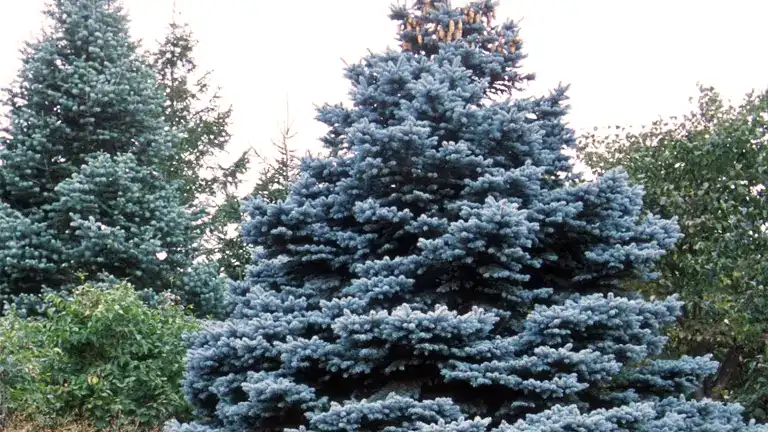
As the seasons passed, I witnessed the Colorado Blue Spruce embark on a journey of steady growth. From its slender and vibrant beginnings, the tree quickly established itself as a robust presence in my garden. What struck me most was its commitment to putting down strong, resilient roots from the very start. This unwavering foundation gave me confidence that my Blue Spruce would not only flourish but also endure for years to come.
- Choosing the Location: Select a sunny spot with well-drained soil, considering the tree’s mature size.
- Planting: Dig a hole twice as wide as the root ball, place the tree at the same level as the surrounding soil, fill the hole, and water thoroughly.
- Watering and Mulching: Keep the soil consistently moist but not waterlogged, and apply mulch around the base to retain moisture and regulate soil temperature.
- Pruning and Maintenance: Prune for health and aesthetics, watch for pests and diseases, and apply a slow-release fertilizer in early spring as needed. With proper care, your Colorado Blue Spruce will flourish and adorn your landscape for years to come.
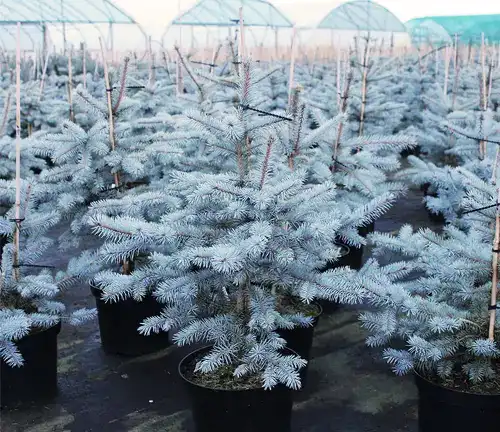
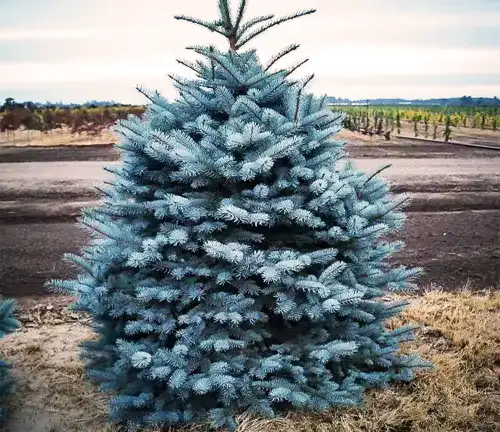
Pros and Cons
Pros
- Year-Round Beauty: One of the most significant advantages of the Colorado Blue Spruce is its year-round beauty. Its striking silvery-blue needles add an element of elegance to your landscape, and it remains attractive throughout all four seasons, making it an excellent choice for those who appreciate aesthetic appeal in their gardens.
- Winter Charm: During the winter months, the Colorado Blue Spruce truly shines as it transforms into a captivating winter wonderland. Its sturdy branches can support heavy snow, creating a picturesque and festive scene in your garden.
- Wildlife Attraction: This tree is a magnet for wildlife, particularly birds. The dense branches provide a safe haven for nesting birds, making it a fantastic choice for bird enthusiasts who enjoy watching avian visitors in their gardens.
- Low Maintenance: Colorado Blue Spruce trees are relatively low-maintenance once established. They are resilient, able to withstand drought conditions, and don’t require frequent pruning. This makes them a practical choice for those who want a beautiful tree without a significant maintenance commitment.
Cons
- Size: Colorado Blue Spruce trees can grow quite large, so they may not be suitable for smaller yards or spaces with limited room. The mature size of the tree should be considered when planting it in your garden.
- Needle Drop: Like many evergreen trees, the Colorado Blue Spruce does shed needles, particularly on the interior branches. This natural needle drop can be more pronounced in older trees, and regular cleanup may be required.
- Susceptibility to Pests: While generally hardy, these trees can be susceptible to certain pests, such as spider mites, aphids, and spruce budworms. Regular monitoring and management may be necessary to prevent infestations.
- Soil Requirements: While adaptable to various soil types, Colorado Blue Spruce trees prefer well-drained soil. In poorly drained or waterlogged soil, they may develop root rot, which can be detrimental to the tree’s health. Proper soil preparation is essential when planting.
Low Maintenance
One of the standout features of the Colorado Blue Spruce is its low maintenance requirements. After the initial stages of establishment, this tree demands minimal care. While it’s crucial to provide regular watering during the first few years of growth to encourage strong root development, once it’s settled in your garden, it becomes a remarkably resilient addition. These spruces are known for their ability to withstand drought conditions and are less susceptible to pests compared to many other trees, reducing the need for constant monitoring and intervention. This low-maintenance quality makes the Colorado Blue Spruce a perfect choice for those seeking a visually appealing and hardy tree that doesn’t demand an exhaustive level of care and attention.
Scotch Pine Tree: A Rustic Classic
The Scotch Pine, scientifically known as Pinus sylvestris, is a magnificent coniferous tree that has graced the landscapes of northern Europe for centuries. Its name evokes images of the rugged Scottish Highlands or the expansive forests of Scandinavia, and rightly so, as it is a quintessential symbol of these regions. With its striking appearance, ranging from the resplendent green of spring and summer to the warm golden hues of autumn, and even the stoic beauty of its evergreen boughs in the midst of winter’s snow, the Scotch Pine is a year-round emblem of natural splendor.
This resilient and aromatic tree, known for its adaptability and low-maintenance nature, has been a steadfast companion in many gardens, parks, and woodlands, providing not only visual delight but also an olfactory journey that can transport you to the heart of a pristine pine forest. In this article, we’ll explore the many facets of the Scotch Pine, from its history and characteristics to its remarkable impact on the environment and the lives it touches, revealing why it stands as a beloved emblem of the coniferous world.
The Arrival
Planting a tree is like welcoming a new member into your family. When my Scotch Pine tree arrived, it was a slender, unassuming sapling, standing at just about two feet tall. Its deep green needles exuded an earthy aroma, and I knew this was going to be the beginning of a beautiful journey. The delicate sapling symbolized hope and growth, a tiny but promising representation of life’s resilience.
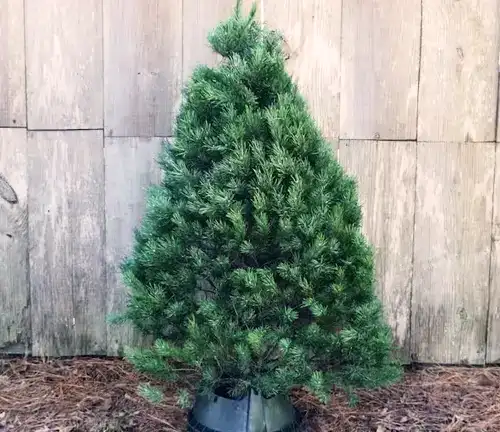
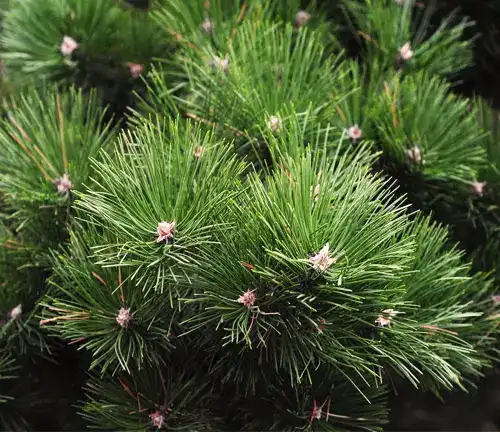
I carefully dug a small hole in my garden, cradled the young tree’s roots, and gently placed it in its new home. The act of planting this tree felt like a solemn commitment to nurture and watch it flourish. With its fresh, fragrant needles brushing against my fingers, it was as if this tree was sharing its story and inviting me to be part of its journey. Little did I know that this modest sapling would evolve into a towering giant, becoming an integral part of my life and my connection to the natural world.
The Growth Spurt
As seasons passed and years rolled by, my Scotch Pine tree grew before my eyes. It was as if I blinked, and the once petite tree had transformed into a robust giant. Scotch Pine trees can reach staggering heights of 30-60 feet or more, and my tree was well on its way. It now stood as a sentinel, casting a soothing shadow over my yard and beckoning a variety of wildlife to its branches. Its transformation was nothing short of remarkable; each year, it added a new layer of growth, its branches reaching out like open arms, embracing the world around it.
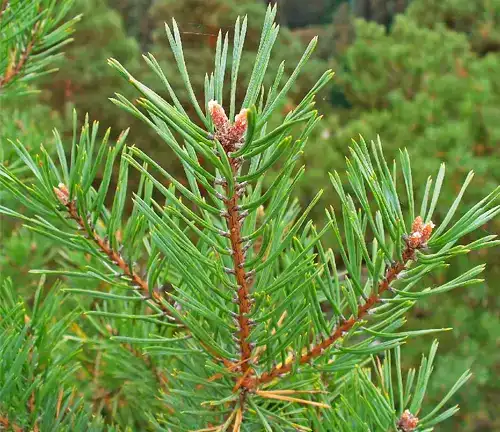
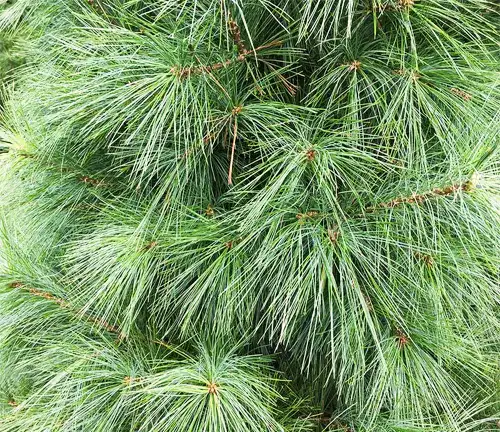
It became a symbol of resilience, a reminder of the power of time and nurturing care. In the heat of summer, it provided a natural shelter from the sun’s scorching rays, and in the depths of winter, it stood as a steadfast guardian against the elements, its branches laden with snow. I marveled at its ability to adapt and thrive, and it became a testament to the enduring beauty of the natural world. This incredible journey from a modest sapling to a magnificent giant is a testament to the enduring spirit of the Scotch Pine and its capacity to inspire awe and wonder in all who have the privilege of nurturing one.
Pros and Cons
Pros
- Year-Round Beauty: The Scotch Pine is known for its year-round visual appeal. It remains green and vibrant throughout the year, providing an evergreen backdrop to your landscape. In spring and summer, its lush, green needles create a picturesque scene, while in the fall, it displays warm golden hues. Even in the heart of winter, it maintains its dignity, standing tall and green, making it a delightful addition to your garden no matter the season.
- Aromatic Pleasure: Perhaps one of the most cherished qualities of the Scotch Pine is its delightful fragrance. Its needles emit a captivating pine scent that fills the air, creating a natural and soothing atmosphere in your surroundings. This aromatic experience can transport you to serene pine forests, making your outdoor space a haven of relaxation and sensory delight.
- Low Maintenance: The Scotch Pine tree is a low-maintenance species, making it an ideal choice for both experienced and novice gardeners. It is highly adaptable to various soil conditions and is generally disease-resistant, reducing the need for frequent care. Regular watering during dry spells and occasional pruning to maintain its shape and health are typically all that’s required to keep this tree thriving in your garden.
Cons
- Invasive Potential: In regions where it is not native, the Scotch Pine can become invasive, crowding out native plant species. This could potentially disrupt the local ecosystem and reduce biodiversity. It’s important to consider the tree’s suitability for your region and follow local guidelines on tree planting to prevent unintended ecological consequences.
- Messy Needle Drop: Like many evergreen trees, Scotch Pines shed needles as they grow. While this is a natural part of the tree’s life cycle, it can create a bit of a mess in your yard. Regular needle cleanup may be necessary, especially if you have the tree in a location where needle drop could be a nuisance.
- Size and Space Requirements: While the impressive height and size of mature Scotch Pine trees can be a pro for some, it can also be a con for those with limited space in their garden. You need to plan for the tree’s growth, ensuring it has enough room to reach its full potential without overcrowding other plants or structures in your garden. This might limit its suitability for smaller urban gardens or confined spaces.
A Haven for Wildlife
My Scotch Pine tree has become a sanctuary for birds and critters. It provides a nesting place for local birds, a hiding spot for squirrels, and even an occasional visit from deer seeking shelter under its branches. Watching the wildlife interact with this tree has brought me immeasurable joy.
Canaan Fir Tree: Newest to the Market
The holiday season has always held a special place in my heart, and the warmth and inviting ambiance of a real Christmas tree have been an integral part of that magic. For as long as I can remember, I’d opted for artificial trees due to their convenience and ease of setup. However, the year before last, I felt a strong desire to break free from tradition and embrace the authenticity of a real tree. That’s when I stumbled upon the Canaan Fir, and little did I know that this decision would breathe new life into my holiday celebrations, rekindling the enchantment and wonder that had somewhat faded over the years.
About Canaan Fir Tree
The Canaan Fir has similarities to other more popular Christmas trees in both growth and appearance. Needles are about 1/2” long with a Light green surface and a silver green underside. The Canaan Fir needles are very soft and grow in a circular pattern straight out of the branch. They have a pleasant fragrance but not as strong as some of the other firs. The strength of the branches are good for hanging medium weight ordainments. Like all firs the Canaan has excellent needle retention.
Here are some things to keep in mind when you get your Canaan Fir home. Before you put it in the stand recut the stump. The tree started a healing process after it was cut to seal the exposed area. A fresh cut will help with keeping the tree fresh while it is in your house. Then after you get it in the stand and set up in your house fill the bowl with hot water the first time. Again the tree is trying to seal the exposed area and this will soften the sap for easier water uptake. After this just make sure to keep water in the bowl at all times. If you do run out fill with hot water again to soften the seal.
The Arrival
From the moment my Canaan Fir tree was delivered to my doorstep, I was captivated by its stunning appearance. As I unwrapped it, I couldn’t help but marvel at the tree’s beauty. Its vibrant green needles glistened in the soft winter sunlight, creating a visual spectacle that filled my heart with excitement. The tree exuded a timeless charm with its classic conical shape, evoking the very essence of what I envisioned as the perfect Christmas tree. As I placed it in my living room, it stood tall and proud, like a majestic sentinel, ready to take its rightful place as the centerpiece of my holiday decorations. Its presence alone transformed the room, instantly making it feel like the heart of our festive celebrations.
Setting It Up
Setting up the Canaan Fir tree was a breeze. I had heard horror stories about tangled lights and hours of assembly for artificial trees, but with this real tree, all I had to do was give it a fresh cut at the base to allow it to absorb water easily, place it in a sturdy stand, and let it settle for a few hours. It didn’t shed many needles, and the entire process was smooth and hassle-free.
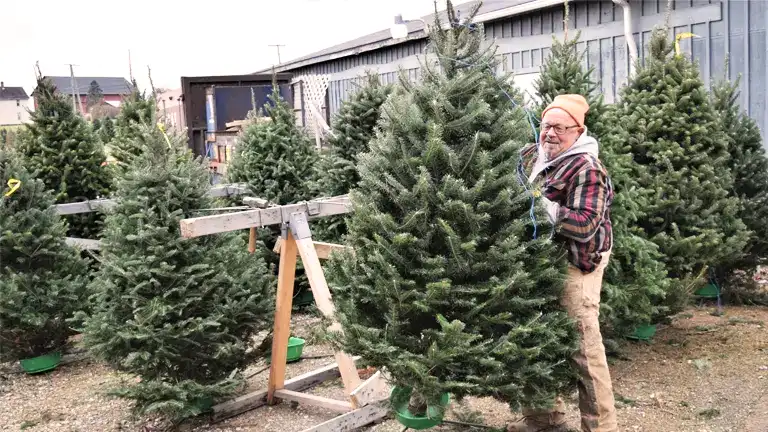
Aromatic Bliss
The Canaan Fir tree brought an unexpected but delightful surprise into my home – its enchanting fragrance. The moment I carried it through the front door, the entire room was immersed in a sweet, forest-like scent that was nothing short of magical. It was an instant trigger for the holiday spirit, reminding me of crisp winter walks through the woods and cozy evenings by the fireplace. The fragrance created an inviting atmosphere, making my home feel warm, comforting, and incredibly festive.
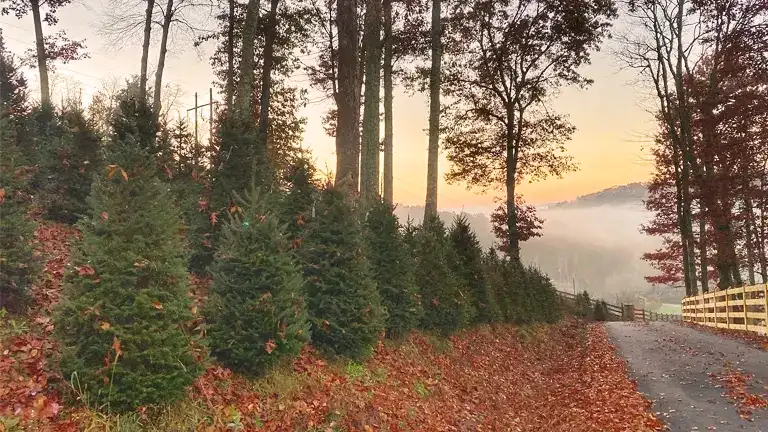
Decorating Delight
Decorating the Canaan Fir tree was an absolute joy. Its sturdy branches effortlessly supported every ornament and string of lights I hung on them. Whether I was adding heavy glass baubles or delicate, hand-crafted decorations, the branches never gave in to the weight; they remained steadfast throughout the holiday season. The tree’s dense foliage was a canvas waiting to be adorned, and it made my ornaments shine brilliantly. I couldn’t have been happier with how the tree looked once it was fully dressed, creating a breathtaking centerpiece for all my holiday celebrations.
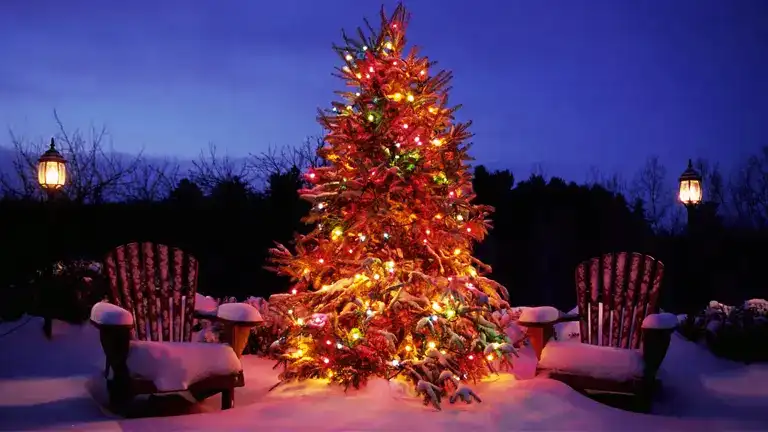
Advantages and Disadvantages
Advantages
- Stunning Appearance: The Canaan Fir tree boasts a classic and visually appealing conical shape with vibrant green needles, making it a beautiful addition to any holiday decor. Its natural charm and aesthetic appeal are hard to match with artificial alternatives.
- Aromatic Delight: One of the most significant advantages of the Canaan Fir is its delightful fragrance. The tree emits a sweet, forest-like scent that instantly creates a cozy and inviting atmosphere in your home, enhancing the holiday experience.
- Sturdy Branches for Decorations: The Canaan Fir’s robust branches can easily support a variety of ornaments, lights, and decorations. Whether you prefer heavy glass baubles or delicate, hand-crafted ornaments, this tree will hold them without sagging, allowing you to create a dazzling holiday centerpiece.
Disadvantages
- Needle Shedding: While the Canaan Fir is known for retaining its needles better than some other tree species, it still undergoes some needle shedding, especially if not properly cared for. Regular watering and keeping the tree away from heat sources can help mitigate this issue.
- Maintenance: Real trees like the Canaan Fir require ongoing maintenance, including watering to prevent drying out, and proper disposal after the holiday season. This can be more time-consuming than the simple storage of an artificial tree.
- Cost: Canaan Fir trees can be more expensive than artificial trees in the short term, but the environmental benefits and the unique holiday experience they provide can make them a cost-effective choice in the long run.
Conclusion
In conclusion, the Canaan Fir tree has brought an enchanting and authentic dimension to my holiday tradition. Its stunning appearance, delightful fragrance, and sturdy branches for decorations have rekindled the magic of the holiday season in my home. The aromatic bliss it provides is a constant reminder of the great outdoors, creating an inviting atmosphere that enhances the holiday spirit. While there are some minor drawbacks such as needle shedding and the need for ongoing maintenance, the unique and heartwarming experience it offers more than compensates for these. Choosing a Canaan Fir tree is not just a holiday decoration; it’s an investment in tradition, ambiance, and sustainability. It brings a touch of nature’s beauty to your home, making it the perfect centerpiece for creating cherished holiday memories with family and friends.
White Spruce Tree: Best Christmas Tree for Ornaments
As a nature enthusiast and avid tree admirer, I recently had the privilege of getting up close and personal with the magnificent White Spruce tree (Picea glauca). It was a magical experience, and I can’t help but share my thoughts and feelings about this remarkable conifer. So, grab a cup of your favorite beverage, sit back, and join me on this journey through my White Spruce tree review.
Aromatic Delight
Upon closer inspection, the White Spruce revealed one of its most enchanting secrets – an irresistible aroma that lures you in with every breath. The scent emanating from this magnificent conifer is nothing short of nature’s perfume.
A blend of crisp, clean pine and zesty citrus notes dance in the air, creating an invigorating olfactory experience. It’s the kind of fragrance that sparks a sense of tranquility and rejuvenation, instantly transporting you to the heart of the wilderness.
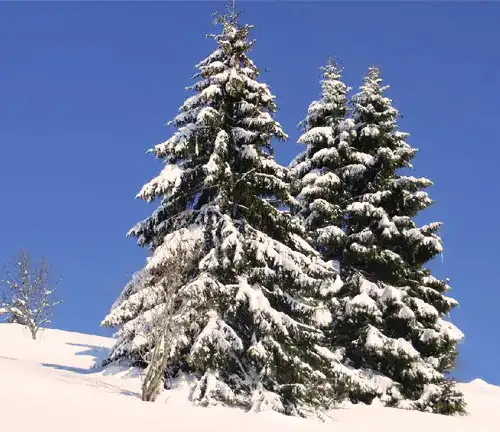
I found myself running my fingers over the fragrant needles, an action that intensified the sensory journey. Each touch released more of this refreshing scent into the surrounding space, leaving me utterly entranced by the White Spruce’s aromatic allure.
Year-Round Beauty
One of the White Spruce’s most remarkable qualities is its unwavering beauty, no matter the season. As I observed this majestic tree, it became clear that it didn’t just wait for the spotlight; it was a star in every act of the year.
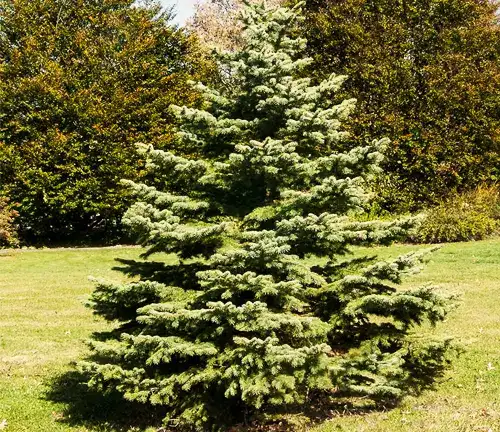
In the midst of winter’s harshest chill, the White Spruce’s evergreen needles stand out against the backdrop of pristine snow. Their vibrant green color offers a stark and stunning contrast, turning the landscape into a living postcard. With the arrival of spring and summer, the White Spruce doesn’t fade into the background; it takes center stage.
Its needles maintain their vivid green hue, ensuring that it remains a visual delight in any setting. This year-round beauty is a testament to the White Spruce’s enduring charm and its ability to bring life and color to the world, regardless of the season.
Environmental Benefits
One cannot discuss the White Spruce without acknowledging its contributions to our environment. This tree plays a vital role in carbon sequestration, helping to mitigate the effects of climate change. Its dense foliage and root system stabilize soil and prevent erosion, making it a true ecological hero.
- Carbon Sequestration: White Spruce trees are effective carbon sinks, absorbing and storing carbon dioxide, which helps mitigate climate change.
- Soil Stabilization: Their dense foliage and extensive root system prevent soil erosion, maintaining the integrity of ecosystems and water quality.
- Wildlife Habitat: White Spruce trees offer refuge and nesting sites for a variety of wildlife, promoting biodiversity and ecological balance.
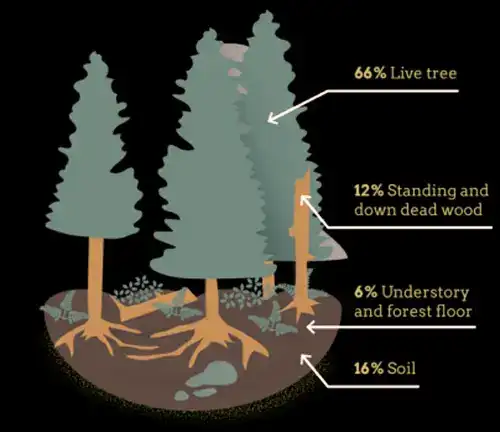
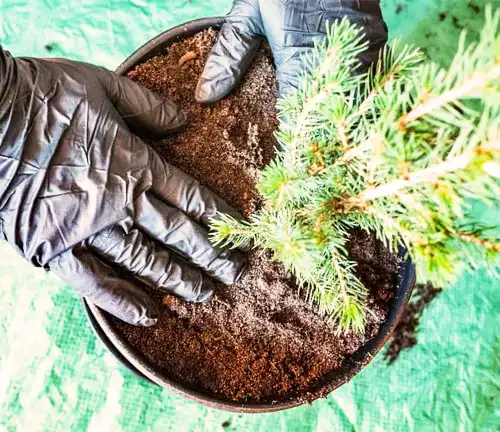
Advantages and Disadvantages
Advantages
- Aesthetic Appeal: White Spruce trees are visually appealing year-round with their evergreen needles. They provide a burst of green in the winter and remain vibrant during the warmer seasons, adding beauty to landscapes.
- Carbon Sequestration: White Spruce trees are excellent at absorbing and storing carbon dioxide, which makes them a valuable tool in mitigating climate change.
- Wildlife Habitat: These trees offer shelter and nesting sites for various wildlife, promoting biodiversity and contributing to the health of local ecosystems.
- Adaptability: White Spruce trees can thrive in a range of soil types and climates, making them a versatile choice for landscaping and reforestation projects.
Disadvantages
- Large Size: The White Spruce can grow quite tall, which may not be suitable for small or urban gardens, as they may block sunlight and take up a significant amount of space.
- Needles Shedding: Like all evergreen trees, White Spruce trees do shed needles, which can create litter in the yard or garden that needs regular cleanup.
- Susceptible to Pests: White Spruce trees can be vulnerable to certain pests and diseases, such as spruce budworm and rust, which can require management and treatment.
- Slower Growth: While they are hardy trees, White Spruce trees have a slower growth rate compared to some other conifer species, meaning it may take longer to achieve their full mature size.
Arizona Cypress Tree: Best Slim Christmas Tree
I’ve always had a penchant for unique and beautiful trees to adorn my backyard. So, when I stumbled upon the Arizona Cypress (Cupressus arizonica) at my local nursery, I couldn’t resist adding this remarkable evergreen to my collection. In this review, I’ll share my experience with the Arizona Cypress and why it has become a cherished member of my garden.
The Arrival
The Arizona Cypress captured my attention from the moment I laid eyes on it at my beloved local nursery. Its presence was simply captivating, standing tall and slender amidst a sea of other trees. What drew me in was its remarkable blue-green foliage, a delicate and feathery texture that set it apart from the rest.
It was as if this tree possessed an intrinsic allure, an invitation to bring a piece of its unique charm into my own backyard. It was a decision made in an instant – I knew I had to take one home. This marked the beginning of my delightful journey with the Arizona Cypress, an ornamental evergreen that has since added an exquisite touch to my garden.
Year-Round Beauty
One of the standout features of the Arizona Cypress is its stunning blue-green foliage. These scale-like leaves are aromatic, exuding a fragrance that fills the air on warm days. I often find myself sitting under its branches, enjoying the subtle scent that takes me on a mental journey to the Arizona wilderness.
The tree retains its vibrant color throughout the year, adding a touch of green even during the cold winter months when other trees in my garden shed their leaves. This evergreen nature makes it a focal point of interest, offering a backdrop for my garden’s transformation through the seasons.
Planting and Care
Planting and Care Planting my Arizona Cypress was a breeze. The tree’s well-developed root system made it easy to establish, and it thrived in a sunny spot in my backyard. I was amazed by how little maintenance it required. It’s drought-tolerant, which is a huge plus in my arid climate. However, it appreciates regular watering during its initial establishment period.
- Choosing the Right Location: When planting an Arizona Cypress, select a sunny spot in your garden. These trees thrive in full sun, which means they require at least 6 to 8 hours of direct sunlight each day. Ensure that the chosen location is well-drained, as the tree doesn’t tolerate standing water. Avoid low-lying or waterlogged areas to prevent root rot.
- Well-Developed Root System: One of the advantages of the Arizona Cypress is its well-developed root system, which makes it relatively easy to establish. When transplanting, be gentle with the roots and plant it at the same depth it was in the container or nursery. This ensures a smooth transition, and the tree can quickly acclimate to its new environment.
- Low Maintenance: The Arizona Cypress is known for being low maintenance once established. It’s highly adaptable to a variety of soil types and is relatively pest and disease-resistant, requiring minimal intervention. Prune it as needed to maintain its desired shape or size, but generally, it maintains its elegant form naturally.
- Drought Tolerance with Initial Watering: While the Arizona Cypress is indeed drought-tolerant once established, it’s crucial to provide regular watering during its initial establishment period. Typically, this period lasts for the first year or until the tree’s root system is well-established. Water deeply but infrequently to encourage deep root growth and resilience. Once it’s established, you can rely on natural rainfall for moisture, making it an excellent choice for arid or dry climates.
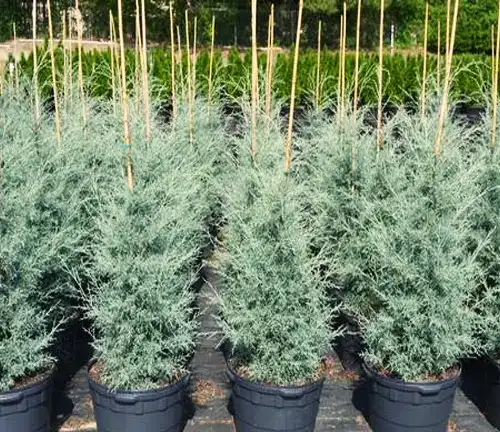
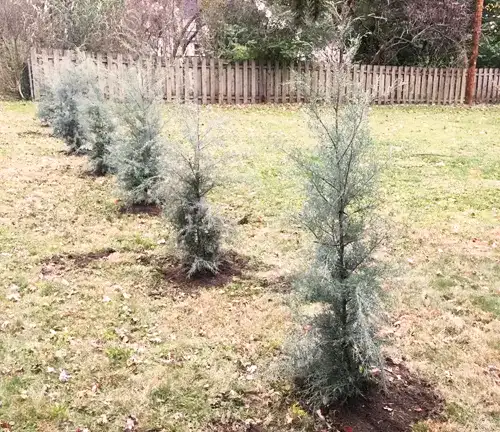
Wildlife and Biodiversity
The Arizona Cypress has done wonders for the biodiversity in my backyard. It’s not just a beautiful addition to my landscape; it’s a hub for wildlife. Birds, particularly sparrows and finches, have found a haven in its branches. They often seek shelter there and, occasionally, build nests, creating a charming avian community. Watching these birds flit about, chirping and soaring, adds a delightful and authentic touch of nature to my everyday life. It’s like having a small wildlife sanctuary right in my backyard. The tree has also had the occasional visit from butterflies, which further enriches the biodiversity of my garden. This interaction with the local fauna has transformed my garden into a dynamic and thriving ecosystem that I’m grateful to witness daily.
Resilience and Growth
The Arizona Cypress has proven to be an extraordinarily resilient tree. It can endure a wide range of weather conditions, from scorching summer heat to freezing winter cold, without compromising its elegance.
The tree’s adaptability and capacity to maintain its vibrant blue-green foliage year-round are truly remarkable. Over the years, I’ve witnessed its steady growth, and it has added an element of grace and height to my landscape.
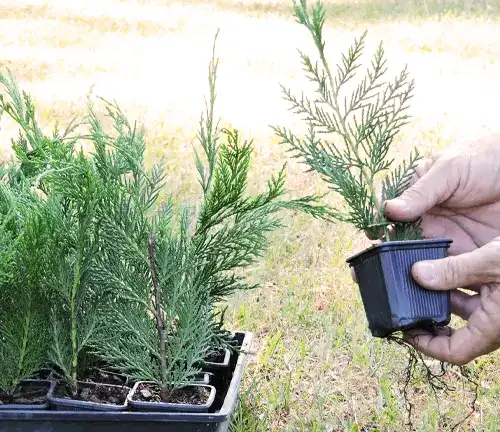
With the right care and maintenance, Arizona Cypress trees can reach impressive heights of up to 40 feet, and I’m excited to see mine gradually achieve its full potential. Its resilience and graceful growth make it a testament to the enduring beauty of nature and a valuable addition to any garden.
Conclusion
In 2025, choosing the best natural Christmas tree means considering your preferences and the specific characteristics of the tree species. If you desire a classic and timeless look, the Balsam Fir tree is an excellent choice, with its iconic triangular shape and wonderful fragrance. For those in pursuit of the prettiest Christmas tree, the Colorado Blue Spruce’s stunning blue-gray needles offer a unique and eye-catching aesthetic. If you appreciate rustic charm, the Scotch Pine tree boasts bright green needles and a cozy ambiance. On the other hand, if you’re intrigued by the newest arrivals, the Canaan Fir tree, with its excellent needle retention, may be a delightful choice. For a tree that’s perfect for showcasing your cherished ornaments, the White Spruce tree’s sturdy branches can’t be beaten. And if you’re working with limited space, the Arizona Cypress, being the best slim Christmas tree, will fit snugly into any cozy corner while still bringing the holiday spirit to life.
Frequently Asked Questions
- How do I decide between the Balsam Fir and Colorado Blue Spruce for a classic and attractive Christmas tree?
Consider your preference for fragrance; Balsam Fir offers a classic Christmas scent, while the Colorado Blue Spruce boasts a unique blue-gray hue. - What’s the maintenance like for a Scotch Pine, and is it suitable for my rustic-themed decor?
Scotch Pine may require regular watering for optimal needle retention, making it a great choice for rustic decor enthusiasts who don’t mind a bit of upkeep. - Is the Canaan Fir a good choice for those who like to stay on-trend with the latest tree options?
Absolutely! The Canaan Fir, being a newer addition, offers an appealing option for those seeking a fresh twist on tradition. - Why is the White Spruce considered the best Christmas tree for ornaments?
The White Spruce features sturdy branches and short, stiff needles that can support a wide variety of ornaments and decorations without drooping. - Is the Arizona Cypress a space-efficient choice, and is it a good alternative for small homes?
Indeed, the Arizona Cypress’s slim profile makes it an excellent choice for tight spaces, ensuring you can still enjoy a festive tree in a smaller living area. - Can I mix and match these tree varieties for a more diverse holiday decor scheme?
Absolutely, combining different tree types can create a unique and visually engaging Christmas decor arrangement. - Do any of these trees have exceptional needle retention, reducing the need for frequent cleanup?
The Fraser Fir and Noble Fir, while not listed here, are known for their superb needle retention, making them a fantastic option for minimal maintenance. - Are any of these trees eco-friendly or more sustainable choices for environmentally-conscious consumers?
If sustainability is a priority, consider sourcing a tree from a local tree farm and recycling it after the holidays, promoting a more environmentally friendly approach to Christmas tree selection.
Your thoughts and experiences matter! We’re eager to hear about your personal journeys in selecting the perfect natural Christmas tree for 2025. Whether you’ve embraced the classic charm of the Balsam Fir, marveled at the unique beauty of the Colorado Blue Spruce, or found rustic solace in the Scotch Pine, your insights can be invaluable. If you’ve explored the novelty of the Canaan Fir, bedecked the White Spruce with your treasured ornaments, or celebrated the holidays in tight quarters with the Arizona Cypress, we want to know. Your stories and choices in Christmas trees can illuminate the path for others, helping them craft their ideal holiday atmosphere. So, don’t hesitate to share your experiences and thoughts in the comments section below, as your wisdom may just be the guiding light someone needs in choosing their best natural Christmas tree for a memorable 2025 celebration!

Edward Smith
Forestry AuthorWoodworking is about more than crafting; it's a harmonious connection with nature, mastering tools, and preserving our environment. I'm here to share my knowledge and experiences with you, forging a future where we can embrace wood's beauty and utility while safeguarding our forests' health and diversity.

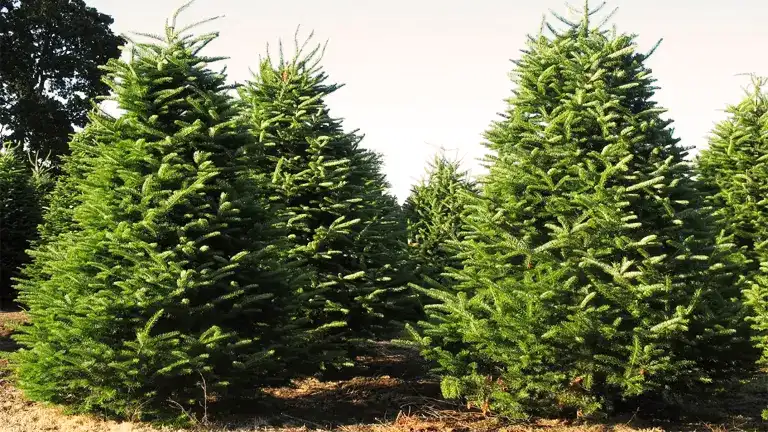
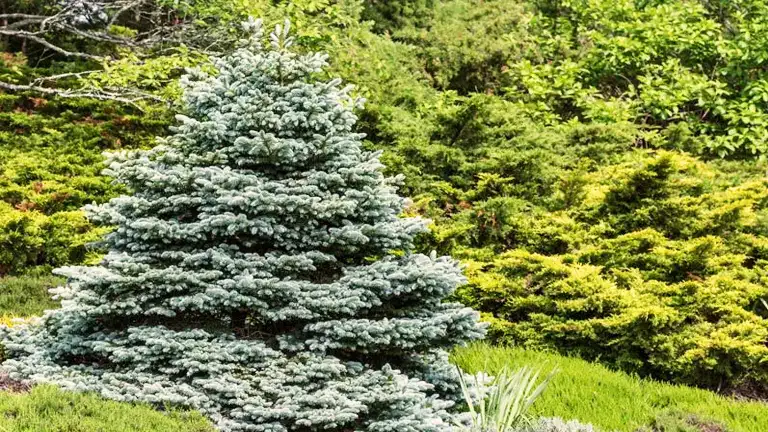
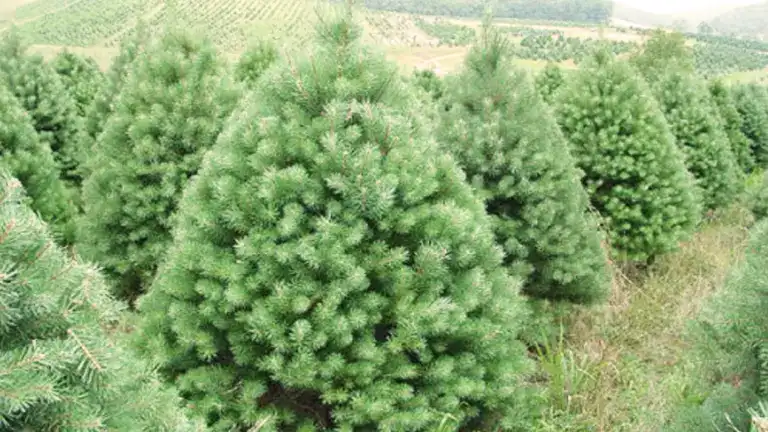

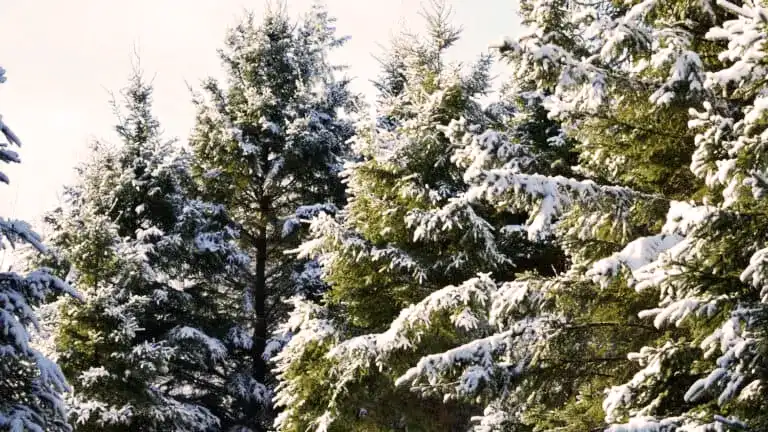
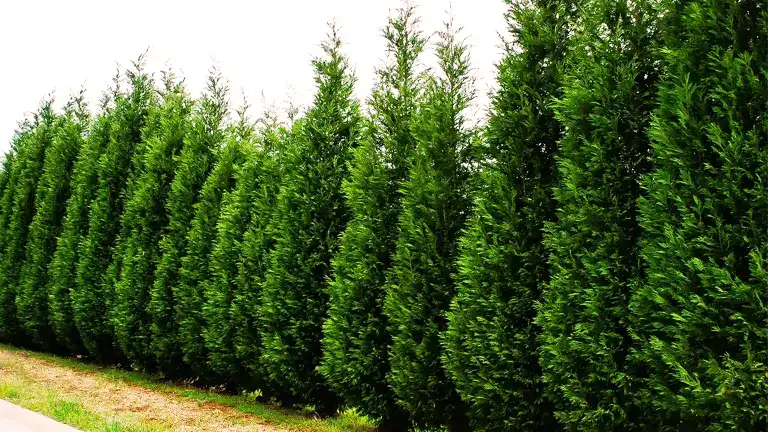
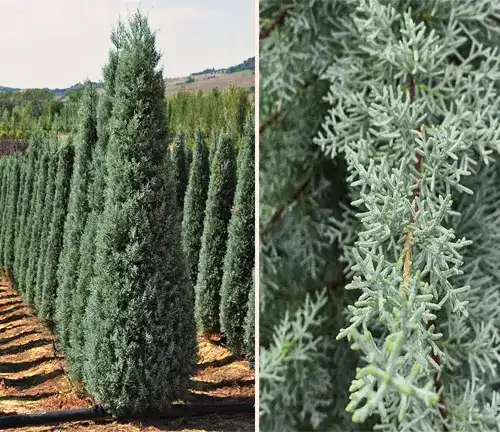




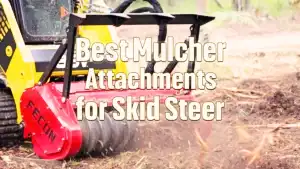
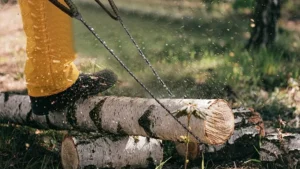







Leave your comment